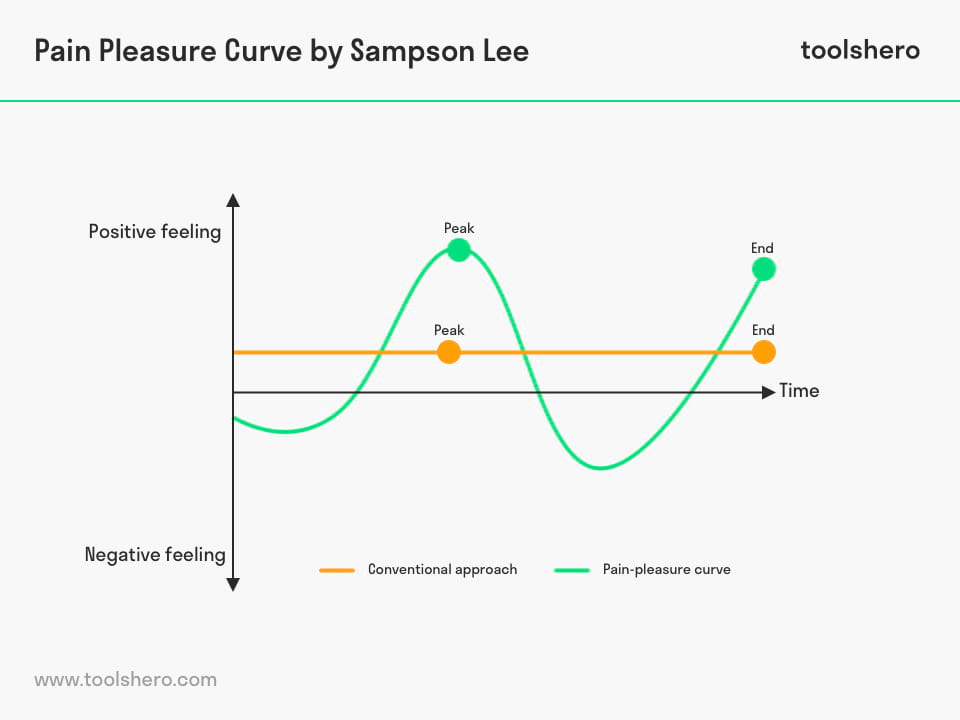Pain Pleasure Curve

Pain Pleasure Curve: this article explains the Pain Pleasure Curve, developed by Sampson Lee in a practical way. After reading it, you will understand the basics of this useful marketing strategy.
What is the Pain Pleasure Curve?
It was the American marketing guru Sampson Lee who founded the Global Customer Experience Management (CEM) at the start of this century. As the name suggests, his aim was to research customer experiences.
In addition, Lee is also author of the Harvard Business Review (HBR); an influential professional journal in the field of business economics. Here he first wrote about the so-called ‘pain-is-good’ (PIG) strategy.
In addition to attention for the customer, Lee believes it is not all that important to completely remove negative customer experiences.
His motto is ‘pain is good’, which implies that it is okay for customers to have negative experiences from time to time. In most cases, customers will not leave a company directly. Instead, they will return based on those components that they experience as particularly pleasant.
Customer Experiences
The Israeli psychologist Daniel Kahneman states that people only remember two experiences; the peak and the end of the experience.
Lee’s Pain Pleasure Curve works precisely on this basis. In the conventional approach to customer experience, organisations try to do everything they can to fully satisfy the customer. Customers are more or less ‘pampered’ from beginning to end. Lee indicates that excellent service requires a lot of capital and, in the long term, doesn’t always have the desired effect.
When customers are dissatisfied about something, Lee describes this as them experiencing ‘pain’. Alternatively, if customers are satisfied, he refers to this as ‘pleasure’. Based on Kahneman’s findings, it is not necessary to continuously provide satisfactory experiences. By using ‘pleasure’ at the start, middle and end, customers will forget any moments of ‘pain’.
A Customer-oriented Approach
According to Lee, taking on a continuous customer-oriented approach involves certain risks. For example, he believes organisations are unable to maximise all aspects of customer satisfaction.
It is therefore best to optimise a so-called ‘pain-pleasure-gap’. So-called peaks of pain and troughs of pleasure will contribute more to a pleasant experience in the customer’s mind.
Dissatisfied customers will experience a certain degree of pain. Think of long waiting times on the phone or in a shop queue, limited payment options in a web shop, loud background music in a restaurant or shop, bad lighting in fashion stores, unfriendly treatment by staff, and so on. Organisations constantly work on eliminating such pains and on improving themselves when it comes to customer satisfaction.
Regardless, Lee indicates not to focus on eliminating all of these complaints. After all, customers won’t just leave, and removing every element of dissatisfaction requires a lot of capital.
In order to implement this philosophy and create a paradigm shift, companies will have to change their approach. They must realise that the so-called peaks of pleasure can mitigate many of the troughs of pain. This is also referred to as the Resource Revolution; the revolution of means.
Pain Pleasure Curve Example
A European Bank used the aforementioned Resource Revolution and consciously let people stand in line for longer. This resulted in a lot of complaints (pain). At the same time, the bank invested in resources such as personal attention and customer services and solutions.
Naturally, this resulted in positive sentiment among customers (pleasure). Ultimately this ensured customers would continue to return and that, on the whole, customer satisfaction increased. As a result, customers would purchase more investment products and other services from the bank.
Major brands such as IKEA and Apple are very much aware of this strategy. IKEA knows very well that the long waiting times in its restaurants and at the counters are annoying to customers.
Moreover, visitors must first traverse the entire store and large warehouse before they have to wait in a long queue to pay for their products. This causes a lot of pain.
On the other hand, IKEA invests a lot in free parking spaces, the ability to take products home directly from stock, delivery services, and a play paradise for kids. This provides the customer with so much pleasure that they forget the pain and keep returning to the store.
Alternatively, electronics company Apple offers products that are not always compatible with other operating systems. This causes a lot of annoyance among customers (pain). However, because Apple provides quality service and products, this compensates for the incompatibility with other systems.
Such pains are important for customers. It is precisely the peaks of pleasure that provide customers a highly memorable brand experience. In an ideal situation, the peak experiences are directly linked with the brand promises.
According to Lee, the brand experience should therefore always end on a peak of pleasure. For instance, in the examples of IKEA and Apple, this is the high quality customer service that is provided afterwards.
Customer Loyalty
Continuous improvement is not the only way to please customers. Of course, the overall goal of every organisation is to increase customer loyalty.
The more loyal the customer, the more products they will buy. It is important that customers truly remember the organisation. An unforgettable brand experience creates loyalty.
In order to stand out, organisations should distinguish themselves and focus on core competencies, making them directly recognisable. Organisations do not necessarily have to strive for excellence. After all, the customers will remember that which gave them a pleasant experience.
According to Lee, a constant stream of improvements places the focus on the wrong aspects. Creating memorable customer experiences, distinguishing the brand, and expanding on core competencies are the most effective solution.
Peaks of Pleasure and Pain
Without troughs of pain, the peaks of pleasure would not be as evident. The troughs of pain are necessary to provide contrast to the peaks of pleasure.
If customers have to experience pain, the peaks will be experienced as even more pleasurable. According to Lee, the idea of striving for excellence, complete customer-orientation, and continuous improvement is an outdated philosophy.
By avoiding pain, excellence becomes nothing more than routine and will no longer feel sincere. Customers don’t become more satisfied when their discontent is removed. The experiences people have create certain ‘anchors’. They compare experiences with each other and ultimately opt for the company that gives them the best feeling.
It’s Your Turn
What do you think? Have you ever heard of the Pain Pleasure Curve? Do you recognize the practical explanation or do you have more suggestions? What are your success factors on customer management, engagement and optimizing customer experience?
Share your experience and knowledge in the comments box below.
More information
- Berry, L. L., Carbone, L. P., & Haeckel, S. H. (2002). Managing the total customer experience. MIT Sloan management review, 43(3), 85-89.
- Lee, S. (2014). PIG (Pain Is Good) Strategy: Make Customer Centricity Obsolete and Start a Resource Revolution. iMatchPoint Limited. Hong Kong.
- Verhoef, P. C., Lemon, K. N., Parasuraman, A., Roggeveen, A., Tsiros, M., & Schlesinger, L. A. (2009). Customer experience creation: Determinants, dynamics and management strategies. Journal of retailing, 85(1), 31-41.
How to cite this article:
Mulder, P. (2018). Pain Pleasure Curve. Retrieved [insert date] from Toolshero: https://www.toolshero.com/marketing/pain-pleasure-curve/
Published on: 08/08/2018 | Last update: 03/25/2022
Add a link to this page on your website:
<a href=”https://www.toolshero.com/marketing/pain-pleasure-curve/”>Toolshero: Pain Pleasure Curve</a>













